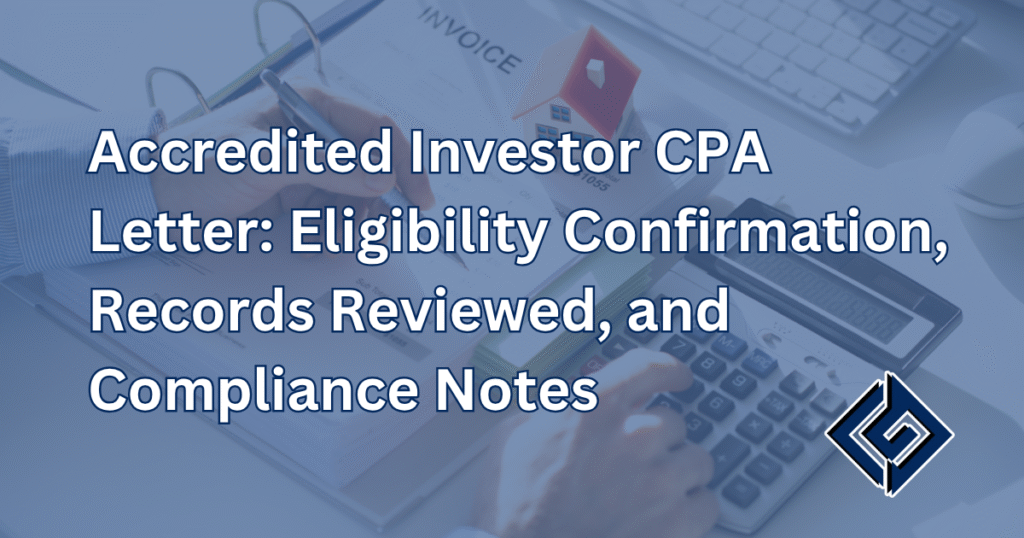An accredited investor CPA letter confirms status for a private offering.
It states criteria met, lists records reviewed, and sets limits.
It helps the broker and issuer complete underwriting without delays.
What This Letter Is—and Why It Matters
A licensed CPA issues a short letter on firm letterhead.
It confirms the investor meets one or more SEC eligibility tests.
It supports the issuer’s file and internal controls.
Where it’s used
- Private placements and subscription packets.
- Secondary checks for transfers or refinancing events.
- Periodic re-verification when offerings require an updated letter.
Why sponsors request a CPA letter
- Independent accounting review improves accuracy.
- It reduces back-and-forth with lenders and compliance teams.
- It aligns with investor due diligence.
Eligibility Paths a CPA Can Confirm
The letter cites the exact test(s) satisfied.
It documents the period and records used.
Common tests
- Income test: prior two years above the threshold; current-year expectation noted.
- Net worth test: assets minus liabilities above the threshold, excluding primary residence.
- Professional test: certain licenses or roles, when applicable.
Ownership context
If investments are held via an entity, note ownership percentages.
The letter clarifies whether the entity itself qualifies.
Records a CPA Typically Reviews
Scope is narrow and verifiable.
No audit is performed unless separately engaged.
Examples of source documents
- Filed IRS tax returns and W-2/1099 schedules.
- Recent financial statements or a GAAP-based net worth schedule.
- Brokerage statements, bank statements, and debt schedules.
- For professional criteria: active license or certification evidence.
Tie-outs and consistency checks
- Compare totals to statements.
- Recalculate simple ratios.
- Confirm dates align with the offering’s requirement window.
Standards, Limits, and Professional Position
The work follows AICPA(American Institute of Certified Public Accountants) ethics and third-party letter boundaries.
Wording avoids overreach.
What the letter does not do
- It is not an audit or review under assurance standards.
- It does not provide audit reports, legal advice, or investment advice.
- It does not opine on price, interest, or future performance.
Why limits matter
They protect the investor, the issuer, and the CPA’s professional liability position.
They also help downstream users—administrators, transfer agents, and money lenders—rely on clear scope.
Accredited Investor Letter Sample
Subject: Accredited Investor CPA Letter — [Investor Name]
I am a CPA for [Investor/Entity]. For the period ending [date], I reviewed the documents listed below to evaluate accredited investor status.
Records Reviewed: filed tax returns, W-2/1099 schedules, recent asset/liability statements, and account statements.
Conclusion: Based on these records, [Investor/Entity] satisfies the [Income / Net Worth / Professional] test as of [date].
Procedures were limited to comparisons and recalculations. This is not an audit or review under AICPA standards, and no opinion is expressed on valuation, appraisals, or future results
[Name], CPA — [Firm], License [State] | Date | Signature
How This Fits With GAAP, Tax, and Compliance
The letter uses consistent terms from GAAP(Generally Accepted Accounting Principles) and tax filings.
It keeps the file easy to read across teams.
Accounting alignment
- Use GAAP captions for financial reporting when summarizing assets and liabilities.
- Bridge to tax figures only when needed.
Compliance alignment
- Issuer compliance checks the letter against the subscription package.
- The letter supports creditworthiness reviews when a fund uses loans or a money lender.
References CPAs rely on
- American Institute of Certified Public Accountants ethics and guidance.
- Practical interpretations from the Journal of Accountancy.
When a “CPA Letter Use of Business Funds” Is Also Needed
Some sponsors ask how invested funds will be used at the entity level.
A separate cpa letter use of business funds can confirm purpose and source for transparency.
Typical add-on items
- Purpose: acquisition, working capital, or refinance at the portfolio.
- Source: committed capital, credit facility, or distributions.
- Records: cash ledgers, bank statement, and management schedules.
Why add this
It helps the sponsor’s underwriting memo.
It keeps investors, brokers, and administrators aligned.
Delivery, Fees, and Timing
Short timelines are common once documents are complete.
Fees depend on complexity and the number of tests to confirm.
Output format
- Letter on firm letterhead with CPA name, license, and signature.
- PDF provided via secure portal or encrypted email.
- Update versions show revision dates.
Coordination with your broker or platform
- Confirm the exact wording and look-back period.
- Share the recipient’s preferred upload method.
- Note any re-verification cadence.
Risk, Controls, and Downstream Use
The letter supports the issuer’s internal controls.
It also helps downstream checks in transfers or redemptions.
For lenders and administrators
- Confirms status in a form easy to test.
- Reduces rework at capital calls or refinancing.
For investors
- Keeps sensitive data minimal in the final letter.
- Full documents stay with the CPA and investor.
